The main diseases of orchids and their treatment
Florists, acquiring a beautiful indoor plant, try to maintain its healthy appearance. But this can be prevented by orchid disease. They develop for various reasons. It is necessary to start treatment on time so that the flower does not die.
- Disease development factors
- Fungal diseases
- Brown rot
- Black rot
- Root rot
- Gray rot
- Fusarium rot
- Neck rot
- Anthracnose
- Powdery mildew
- Rust
- Sooty (black) mushrooms
- Cercosporosis
- Mold
- Bacterial spot
- Viral diseases
- Other diseases
- Incorrect illumination
- Wrong watering regime
- Incorrect temperature conditions
- Incorrect dosage of fertilizers
- Compaction of the substrate
- Sub-optimal humidity
- Pests
- Conclusion
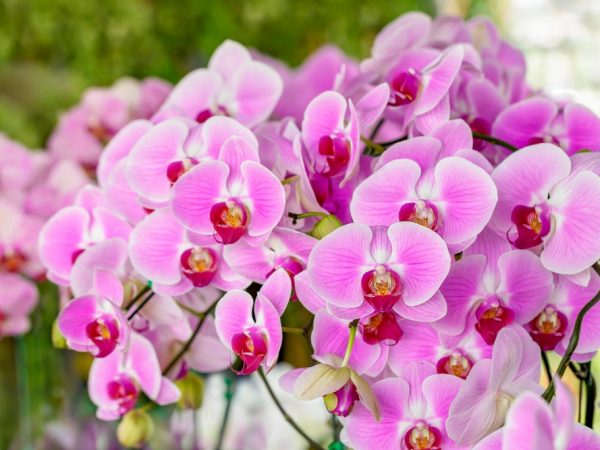
The main diseases of orchids and their treatment
Disease development factors
When buying a plant, it is worth considering the needs of a particular species and the possibility of meeting them. Phalaenopsis diseases often manifest themselves due to illiterate care:
- improper watering;
- dry air;
- poor lighting;
- inappropriate temperature;
- excess or lack of nutrients.
Also, orchid diseases in indoor conditions are provoked by such factors:
- invasion of parasites;
- fungal, viral and bacterial pathogens;
- non-disinfected wound.
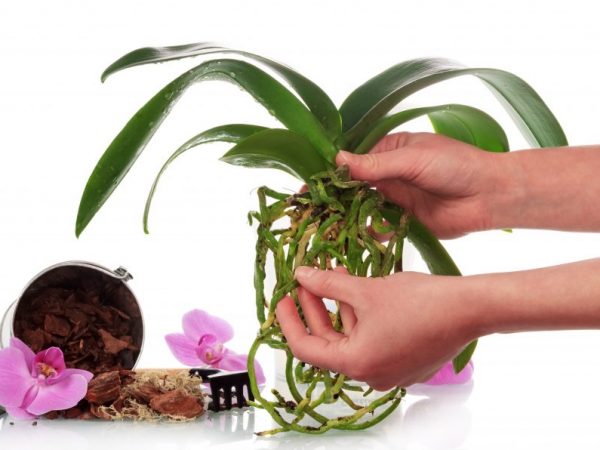
Phalaenopsis diseases often manifest themselves due to illiterate care
It is worth protecting the flower from pests that may be:
- on a new plant brought into the house;
- on a flower bouquet;
- in an uncontaminated substrate;
- on infected vegetables or fruits that are nearby.
Fungal diseases
Orchids infect various fungal diseases.
Brown rot
Most often it appears on young leaves as light brown, watery spots. Over time, they occupy more and more areas on plants, blacken and join. Shoots are also affected. It develops with abundant watering and low temperatures.
If the orchid has just started to hurt, then the treatment is as follows:
- damaged areas are cut out with a sharp instrument, capturing healthy tissue;
- the places of the cuts are treated with crushed coal;
- sprinkle with copper-containing substances.
If the crop is completely stained, it is better to discard it so that brown rot does not spread to healthy plants. It is no longer possible to save flowers.
To prevent disease, the culture is treated with copper sulfate. It is used once a month. Orchids of the Phalaenopsis, Cymbidium, Cattleya, Pafeopedilum varieties are susceptible to the disease.
Black rot
The reasons for the appearance of black spots on the leaves:
- spraying with water in a cold room;
- poor ventilation;
- weakened plant immunity due to disease or pest infestation.
Fight black rot by cutting out damage with a disinfected knife. The wounds are treated with charcoal or Bordeaux mixture. The plant is transplanted. The substrate is replaced, the pots are sterilized. If the leaves are completely blackened, they throw it away. Crops growing nearby are sprayed with preparations that contain copper.
For prevention, the orchid provides the proper conditions.Among the varieties that are most susceptible to this disease are Cattleya and Papheopedilum.
Root rot
Symptoms are brown leaves, the roots are stained, then shriveled and start to rot. The process moves on to the neck, bulb, rhizome and stems. Leaves lose their turgor, wrinkle, die off and fall off. The conditions for the development of the disease are high temperature and humidity, excessive watering.
For the treatment of root rot, the roots and substrate are processed. To do this, the pot is immersed in a 0.2% solution of Fundazol or Topsin. The procedure is performed in 3 stages with an interval of 10-14 days. The substrate should dry out completely between waterings.
When the root system is badly damaged, it is worth trying to grow a new one. To do this, the rotten areas are cut off, the rest are washed and dried for several hours. The plant is planted in a high-quality, dense substrate. Watering is rare. If young roots have grown, it is worth making sure that the decay process does not start again.
To prevent disease, a disinfected soil mixture is used when planting. More often than others, Cymbidium, Miltonia, Vietnamese Pafeopedilum are affected by this type of rot.
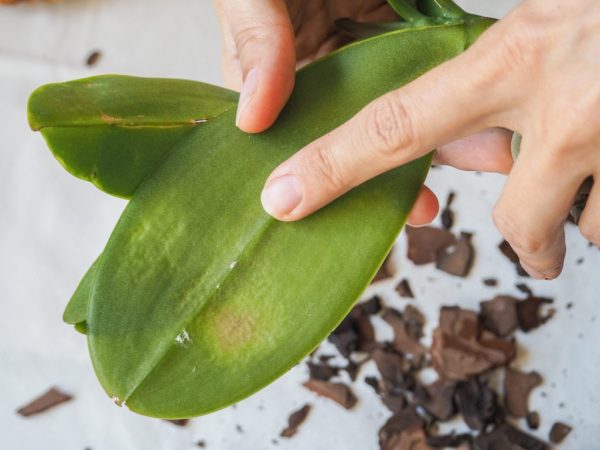
Orchids are susceptible to various fungal diseases
Gray rot
Orchid leaves are first covered with dark spots with a characteristic gray fluffy bloom. Over time, the soil and flowers are affected, on which specks of a brown tint appear.
Reasons for the appearance:
- cold air;
- high humidity;
- excess nitrogen when fertilizing.
Treatment for this orchid disease is to remove damaged areas and spray fungicides from the base of the trunks and leaves to the very tops. One drug is not used twice, since fungi develop resistance to it.
They prevent the development of gray rot by adding immunity-enhancing agents during watering. Flowers are placed far from each other to avoid contamination. Maintain temperature, humidity and dosage of feeding substances at a level appropriate for a particular species. The disease affects Phalaenopsis, Cymbidium, Cattleya.
Fusarium rot
The second name of the disease is tracheomycosis. It starts with root rot, and young shoots are also affected. The leaf plates soften, twist, become covered with a pink bloom, since the mycelium of the fungus clogs the vessels of the plant. Fusarium rot develops when there is poor air circulation in the room and too high humidity.
To revive the plant, take the following measures:
- 3 times a day, a pot with a flower is placed in a 0.2% Fundazole solution. Processing is carried out within 10 days.
- For a while, they stop spraying the culture.
As a preventive measure, the room is ventilated, but they make sure that the flower is not in a draft. The optimum moisture content is also observed. It should be borne in mind that the most susceptible to orchid diseases are Phalaenopsis, Miltonia, Epidendrum.
Neck rot
It is difficult to identify rotting at the initial stages of development, it progresses in the middle. The orchid gradually collapses: the leaves turn yellow near the neck and fall off. The reason is prolonged contact of the roots with water.
If cervical rot has affected the culture, it cannot be cured. Therefore, it is better to observe moderate watering, waiting for the substrate to dry between the roots.
Anthracnose
Dark brown spots with a border are formed on the leaves. Over time, they grow, merge into large areas. It also affects branches and shoots, on which depressed areas appear. They prevent the flow of nutrients to all organs of the culture. The depressions are light brown in color and oblong. They gradually increase. In the later stages of the development of the disease, the depressions acquire brown or dark purple outlines.
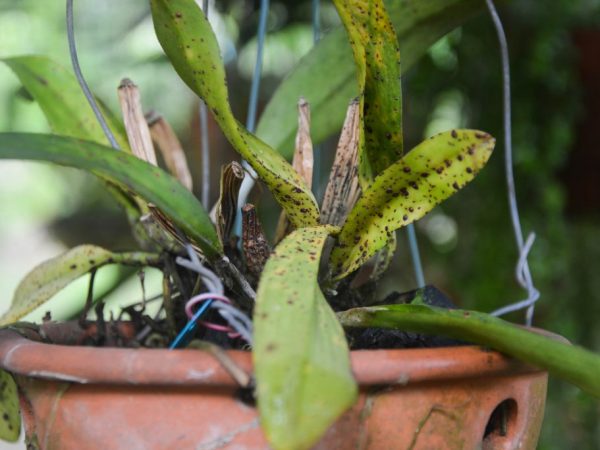
Anthracnose appears as dark brown colored spots with a border
If the room is warm and dry, the affected areas will crack.In high humidity, fabrics rot and break from any touch. If the disease is ignored, then the leaves turn brown, and over time, the entire ground part dies. A favorable environment for the development of the disease is:
- temperature 23 °;
- humidity 87-88%;
- lack of potassium, calcium;
- increased acidity.
When an orchid is affected by anthracnose, it should be treated with fungicides. It is worth treating the plants with Skor or Oxykhom, Fundazol, Ridomil Gold, Previkur or others. Spraying is carried out in 2-3 stages with an interval of 7 days. The preparations Fitosporin-M and Gamair are less harmful to the environment. The damaged areas are removed. After medical manipulations, watering is reduced and feeding is stopped for a while.
The disease problem is prevented by providing the culture with a humidity of 40 to 70%. They also regularly ventilate the premises. The water from the axils of the leaves and cores of the bulb is soaked with a napkin. Phalaenopsis, Miltonia, Oncidium, Pafiopedilum are distinguished by poor resistance to anthracnose.
Powdery mildew
Symptoms of this disease in orchids are a characteristic white bloom on the leaves, stems, and flowers. Leaves eventually turn brown below, yellowish or brownish spots appear on top. Because of this, the process of photosynthesis is disrupted, which slows down the growth and development of the plant. Perforated forms appear. If the litas is wrapped, then the fabrics are deformed. Holes remain on it. The infection spreads in warm and humid environments.
Treatment should be started immediately when the organs of the orchid have turned white. Powdery mildew should be fought with one of such fungicides Topaz, Skor, Hom, copper sulphate, etc. The affected areas are cut and destroyed. The flower should be processed in a cool, dry place. The drug is used at least 3 times with an interval of 10 days.
All varieties are equally susceptible to powdery mildew. To protect the culture from it, you should adhere to the following rules:
- use disinfected equipment;
- transplant the purchased plant;
- etch the substrate;
- take proper care of;
- spray the flower with Fitosporin-M.
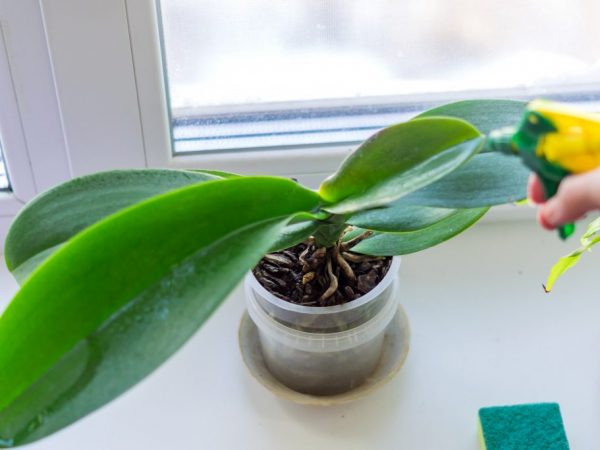
Powdery mildew signs - characteristic white bloom on leaves, stems, flowers
Rust
For the orchid family, the disease is rare. You can determine it by the light spotting below the leaves, which after a while acquires a red color. This is the sporulation of fungi. Affects weakened plants.
You need to get rid of the problem by removing damaged areas or the entire sheet. Places of cuts are treated with crushed activated carbon or 20% alcohol. The plant is sprayed with one of these means: Topsin-M, Ridomil, Skor.
It is worth regularly treating the culture with drugs that increase its immunity. This will prevent rust infestation. It is important to provide proper care.
Sooty (black) mushrooms
The reason for the development of the disease lies in the defeat of the plant by such pests as aphids, mealybugs, white scale insects. A fungus appears on the sweet secretion that they secrete. A black coating forms, which clogs the stomata of the leaves and prevents the access of light. The plant becomes weak and dies over time. Young cultures are amazed.
The disease progresses in rooms with poor air circulation, where the temperature is high. It also develops in an environment with high humidity and overcrowding of indoor plants.
If the culture is sick with black fungus, you should:
- spray it with fungicides - Mikosan is safer, Topsin-M, Skor and Ridomil are also used;
- cut off the affected parts;
- wipe the sooty plaque with a wet sponge or place the orchid under a warm shower;
- then dry it to prevent moisture stagnation;
- if insects are detected, neutralize them with the help of insecticides or folk methods: 1 liter of water, 150 g of crushed soap, 5 g of copper sulfate.
Cercospora
According to the description, it is an infectious disease caused by fungi.A distinctive feature is that areas of a rounded shape (less often stripes) appear, which then turn yellow and merge into large circles. Over time, cover the sheet completely. Old spots take on a brown tint. The disease develops in conditions of low humidity. Cattleya, Cymbidum, Oncidium, Dendrobium are more often affected by cercosporosis. Since the leaves of Cattleya are tough, they turn white or yellow with a disease.
To get rid of cercosporosis, you need to remove the damaged areas, treat the cuts with brilliant green or activated carbon. The plant should be sprayed with a fungicide. The appropriate care for each type will serve as an excellent preventive measure.
Mold
Signs of phalaenopsis orchid disease are also white shaggy bloom on pieces of bark, on the surface of the substrate, roots and stem. This is mold caused by the multiplication of moldy fungi or fungi of wood decay - brown or bacterial decay. Until some time they are in a dormant state, and under favorable conditions they are activated.
If the substrate has become moldy, at the initial stage of the development of the disease, it is loosened and dried. Water the next time when the soil is completely dry. The culture is placed in a lighted area.
When the root system and stems grow moldy, the plant is removed and washed under warm water (30-35˚C). The roots are soaked for 10-15 minutes in a weak fungicide solution. The flower is transplanted by disinfecting the pot and substrate. After that, do not water for 2-5 days. Proper care and hygiene will prevent mold growth.
Bacterial spot
Leaves turn yellow, then darken, become flabby. Covered with depressed sticky spots and weeping ulcers with a yellow rim. Bacteria enter the tissue through microcracks or open stomata. The place of appearance is often the tips of the leaves and the lobar vein.
Treatment of orchids for bacterial spotting at home: remove diseased areas, treat wounds with brilliant green, iodine or activated carbon. The plant is isolated to prevent contamination of other crops. In more complex cases, bactericides or antibiotics are used.
Viral diseases
At home, culture is rarely affected. They appear as a mosaic spot on leaves and flowers. Sometimes the leaf plates become striped or curled up. The spots are still round.
Causes:
- hypothermia or overheating;
- excess or lack of water.
Treatment of this disease in phalaenopsis orchids will not work - they should be got rid of. \
Other diseases
Orchid diseases and their treatment are often associated with inappropriate care.
Incorrect illumination
Poor illumination threatens with such manifestations:
- chopping leaves;
- weak deformed, elongated growths that do not form buds develop.
If white dots or spots appear on the leaves, then this indicates a sunburn. To prevent this, the plant is gradually adapted to the sun in the spring. It is shaded. Do not spray in direct sunlight, so that heated drops of water do not cause burns.
If the buds are withered, the plant does not have enough light. When supplementary lighting in the autumn-winter period, it is worth strictly maintaining a distance of 20-30 cm, otherwise the plant will receive thermal burns. They will dry out over time, but the stains will remain.
Wrong watering regime
If the leaves have drooped, become thin or wrinkled, you should look at the moisture content of the soil.
When the substrate dries up, they also burst in half.
When watering a dry plant, the liquid is quickly delivered to problem areas. It accumulates there, after which the tissues are torn, so watering must be timely.
Swelling appears for the following reasons:
- prolonged contact with water;
- abundant watering in a cool room.
When wet spots appear, it is worth removing them immediately with filter paper, as they grow quickly.Then the plant is threatened with rotting. Do not put it on a cold windowsill after watering.
Incorrect temperature conditions
Do not leave flowers on an unheated balcony in severe frosts so that they do not disappear. When airing, the orchid pots are removed from the window, otherwise the leaves will freeze. From low temperatures, they crack, curl and shrink, the buds become stale.
From hypothermia, cracks appear in the middle or at the edge of the leaves. If their tips are dangling, the plant could suffer from a draft. With sharp changes in temperature, the leaf plates also crack and bifurcate, the edges brighten.
If watering is done correctly, and the leaves wrinkle, it is worth moving the flower to a cooler place. Then the evaporation of moisture will slow down.
Incorrect dosage of fertilizers
When any nutrient is introduced in an arrogant amount, the culture stops development. The roots do not grow, the leaves become lethargic. The burnt root system as a result of an overdose of fertilizers is evidenced by their dead ends. The leaf plates turn brown. Sometimes, as a result of the high sugar content, sticky droplets appear on them. If the leaf has burst, this can also be the consequences of overfeeding.
When there is a lot of nitrogen in the substrate, the leaf blades stretch out. The green mass is growing, peduncles often do not form. If flowering occurs, then there are few buds. An orchid with an excess of fertilizer should be treated with a hot shower. The procedure is performed once a week.
If the leaves have lightened, then the culture does not have enough nitrogen. When they shrivel, the old plants are provided with magnesium, potassium, phosphorus, and the young - boron, copper, manganese.
Compaction of the substrate
If the leaves are limp and flabby, you should look at the condition of the potting mix. Over time, it loses its breathability due to compaction, which is accelerated by soil fungi and algae. Then the roots do not receive sufficient oxygen. They begin to choke.
Sub-optimal humidity
If the culture has thrown off or lowered the leaves down or they become not so elastic, the reason lies in low humidity. It is especially dangerous in combination with high temperatures. Moisture vigorously evaporates from the tissues, the roots do not have time to compensate for it. Bulbs, flowers and buds also dry out. When Phalaenopsis orchids suffer from illness due to poor care, the conditions of detention should be changed, otherwise the plants will disappear. Moisture readings should be above 30-40%.
Pests
If stickiness appears on the leaves - sweet insect secretions, it is worth examining the plant for the presence of such insects:
- aphids;
- whitefly;
- mealybug;
- scabbards.
The shield causes the most problems. It sucks the juice out of the tissues, releasing a sticky secretion. Bumps and growths form on the leaves of the orchid, they wrap up. Pests are removed with an alcohol solution. When there are too many of them, the culture should be treated with Fitoverm. The substrate and pot are replaced.
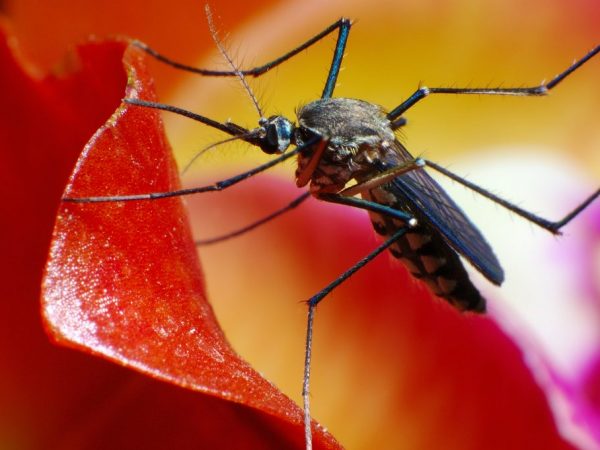
Orchid pest control methods
When cobwebs appear on flowers and buds or on the underside of leaves, the culture is affected by spider mites. With an advanced stage of the disease, the plant loses its turgor, the leaves curl and dry out. The insect sucks the sap from the plant, which leads to its death over time.
Pest control is as follows:
- wash the plant with soapy water;
- they process the place where it was located and the pot;
- watered and put in a plastic bag for 3 days, making sure that the increased temperature does not harm the flower.
The culture is also killed by one type of nematode - light insects 1-2 mm in length. With their invasion, the leaves are deformed, grooves and light spots appear on them. If they are darkened, the disease is already running. The number of colors is then reduced. Dead areas appear on pseudobulbs, and pimples appear on the roots.To combat the nematode, the following manipulations are performed:
- the flower is isolated;
- watered with Decaris or Levamisal solution (1 tablet per 1 liter of water);
- place the plant in a hot shower (40 ° C).
Conclusion
Treatment of phalaenopsis orchid diseases is an important stage in crop cultivation. If the slightest symptoms are detected, urgent action should be taken. Then the disease will not go into a difficult stage.
When buying, you should carefully study the information about the orchid and its diseases. Then you should provide optimal conditions.


